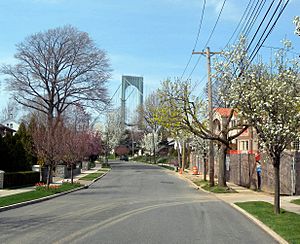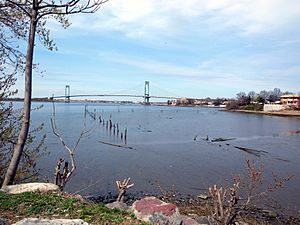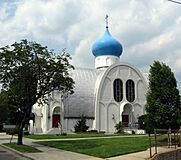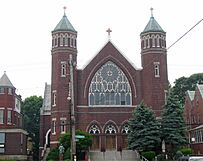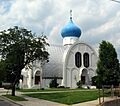Whitestone, Queens facts for kids
Quick facts for kids
Whitestone
|
|
|---|---|
|
Neighborhood of Queens
|
|
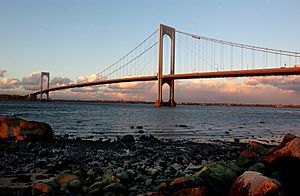
The Bronx–Whitestone Bridge as seen from Whitestone
|
|
| Country | |
| State | |
| City | New York City |
| County/Borough | Queens |
| Community District | Queens 7 |
| Council District | 19th |
| Demonym(s) | Whitestoner, Whitestonian |
| Time zone | UTC−05:00 (Eastern) |
| • Summer (DST) | UTC−04:00 (EDT) |
| ZIP Code |
11357
|
| Area codes | 718, 347, 929, and 917 |
Whitestone is a neighborhood in the northern part of Queens, a borough of New York City. It is mainly a place where people live.
The neighborhood is located next to the East River on its north side. To the west, you'll find College Point and the Whitestone Expressway. Flushing and 25th Avenue are to the south. To the east are Bayside and Francis Lewis Boulevard.
Whitestone also includes a smaller area called Malba. This part is known as one of the fancier areas in Queens. Whitestone is part of Queens Community District 7. Its ZIP Code is 11357. The New York City Police Department's 109th Precinct keeps the area safe.
Contents
History of Whitestone
The name "Whitestone" comes from the white limestone rocks. These rocks used to be found along the river shore. Old documents from the 1600s mention "the white stone." It was a well-known landmark back then.
A large part of this area was once owned by Francis Lewis. He was an important person who signed the Declaration of Independence. During the Revolutionary War, British soldiers attacked his estate. His house was burned down, and his wife was taken prisoner.
For a while, Whitestone was called Clintonville. This was named after Dewitt Clinton, a former governor of New York. You can still see this name in Clintonville Street. In the late 1800s, many rich New Yorkers built large homes here. Before that, it was mostly farmland or woods.
The area grew quickly in the 1920s. This was because trolley and train services expanded into the neighborhood. These services were part of the Long Island Rail Road's Whitestone Branch. However, train service stopped during the Great Depression. Later, parts of the old train tracks were used to build the Belt Parkway. This parkway includes the Whitestone Expressway. The expressway runs along the edge of the old Flushing Airport, which closed in 1985.
More growth came when the Bronx–Whitestone Bridge was finished in 1939. This bridge is 2,300 feet (700 m) long in its middle section. When it was built, it was the fourth-longest bridge in the world.
Malba Subsection History
The name Malba comes from the first letters of five founders of the Malba Land Company. These names were Maycock, Alling, Lewis, Bishop, and Avis. Malba is a very wealthy community within Whitestone. Most people living here are white, with European backgrounds like Greek, Italian, and Irish. There are also Jewish and a small number of Asian American residents. The homes in Malba are usually large and expensive.
The first known person to live in the Malba area was David Roe. He came from England in the 1640s. In 1683, Roe owned 35 acres (140,000 m2) of land. He bought more land over time, including the area that became Malba. His farm was on the east side of a bay, which was called "Roe's Cove."
In 1786, John Powell bought Roe's land. He built a home there, and the cove was renamed "Powell's Cove." This is still its name today. In the 1800s, some of Powell's land went to Harry Genet. He was a member of Tammany Hall, a powerful political group in New York City. Powell's house was destroyed by fire in the 1890s.
Later in the 1800s, the land changed owners several times. In 1883, train service to Manhattan was extended. The train line ended at "Whitestone Landing." This was a popular summer resort area.
William Ziegler, a successful businessman, bought all these lands around 1883. His property became known as the "Ziegler Tract." After Ziegler died in 1905, his former secretary, William S. Champ, and his wife's nephew, W.C. Demarest, bought the land. They planned to develop it.
Development of Malba started slowly in 1908. A train station was added on the Whitestone line. The Champs and Demarests were among the first families to own homes in Malba. By World War I, there were thirteen houses. More than a hundred homes were built in the 1920s. The train station closed in 1932. A small park called "Jane Champ Park" was dedicated in 1969.
Population and People
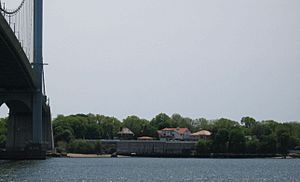
In 2010, Whitestone had about 30,773 people living there. This was a small decrease from the year 2000. The neighborhood covers about 1,584.85 acres (641.37 ha) of land.
Most people in Whitestone are White (about 68%). About 17% are Asian, and 12% are Hispanic or Latino. A small number of residents are African American or Native American.
The average life expectancy in Whitestone and nearby areas is about 84.3 years. This is longer than the average for New York City. Most people living here are middle-aged or older. About 22% are between 25 and 44, and 30% are between 45 and 64.
In 2017, the average household income in this area was $51,284. About 25% of residents live in poverty. This is similar to the rest of Queens and New York City. About 6% of residents are unemployed. Many residents (57%) find it hard to pay their rent.
Places to See
Whitestone has several interesting churches. These include St. Luke's Roman Catholic Church and Holy Trinity Roman Catholic Church. The Grace Episcopal Church was built in 1858. The land for it was given by the family of Francis Lewis.
The Whitestone Hebrew Centre has two buildings. It was started in 1929. The Russian Orthodox Church of St. Nicholas has a unique blue onion dome. This dome was added in 1991. The Greek Orthodox Church, Holy Cross, is also in the area.
Local Businesses
Several companies have operated in Whitestone. Some of these include:
- Kinemacolor Company of America
- Fairchild Recording Equipment Corporation
- Lee Kum Kee International Holdings Ltd.
- Glacéau
- White Rock Beverages
- World Journal
- Queens Tribune
Safety Services
Whitestone has a fire station from the New York City Fire Department (FDNY). It is called Engine Co. 295/Ladder Co. 144. You can find it at 12-49 149th Street.
Mail and ZIP Code
The ZIP Code for Whitestone is 11357. The United States Post Office has two offices nearby:
- Whitestone Station – 14-44 150th Street
- Linden Hill Station – 29-50 Union Street
Education and Learning
Whitestone residents have a similar level of college education to the rest of New York City. About 37% of adults aged 25 and older have a college degree or higher.
Students in Whitestone and Flushing are doing well in school. The number of students doing great in math went up from 55% in 2000 to 78% in 2011. Reading scores also improved.
Fewer elementary school students miss many days of school in Whitestone. Only 9% miss twenty or more days a year. This is lower than the city average of 20%. Also, 86% of high school students graduate on time. This is higher than the city average of 75%.
Schools in Whitestone
The New York City Department of Education runs public schools in the area. These include:
- P.S. 79 Francis Lewis
- P.S. 184 Flushing Manor
- J.H.S. 194 William H. Carr
- P.S. 193 Alfred J Kennedy
- P.S. 209 Clearview Gardens
Private schools include Holy Trinity Catholic Academy and St Luke's School. Whitestone Academy and The Lowell School are private high schools.
The Queens Public Library has a branch in Whitestone. It is located at 151-10 14th Road.
Getting Around Whitestone
The Bronx–Whitestone Bridge connects Whitestone to the Bronx. This bridge carries Interstate 678 (Whitestone Expressway). The Cross Island Parkway also joins the Whitestone Expressway close to the bridge.
The New York City Bus and MTA Bus Company offer several local bus routes in Whitestone. These include the Q15, Q15A, Q16, Q20A, Q20B, Q34, Q44 SBS, Q50, Q76 and express routes like QM2, QM20, QM32. Most local buses connect to the Flushing–Main Street subway station. There is no subway service directly in Whitestone.
The Whitestone Branch was once a train line of the Long Island Rail Road. It ran from Flushing to Whitestone. It had stations at College Point, Malba, and Whitestone Landing. This train line was closed on February 15, 1932.
Famous People From Whitestone
Many well-known people have lived in Whitestone, including the areas of Beechhurst and Malba. Here are a few:
- Gracie Allen (1895–1964), a famous actress and comedian.
- Roberto Alomar (born 1968), a retired baseball player.
- Clara Bow (1905–1965), an actress.
- George Burns (1896–1996), a famous actor and comedian.
- John Cena (born 1977), a popular wrestler and actor.
- Charlie Chaplin (1889–1977), a legendary actor and filmmaker.
- Julie Chen (born 1970), a journalist and TV host.
- Drea de Matteo (born 1972), an actress.
- Harry Houdini (1874–1926), a world-famous magician.
- Buster Keaton (1895–1966), an actor and director.
- Fiorello H. La Guardia (1882–1947), a former mayor of New York City.
- Francis Lewis (1713–1802), a signer of the Declaration of Independence.
- June Lockhart (born 1925), an actress.
- Mary Pickford (1892–1979), a famous actress.
- Dee Dee Ramone (1951–2002), a musician from the band Ramones.
- William Shea (1907–1991), a lawyer and founder of a baseball league. Shea Stadium was named after him.
- Norma Talmadge (1894–1957), an actress.
- Howard Thurston (1869–1936), a magician.
- Rudolph Valentino (1895–1926), an actor.
- Walt Whitman (1819–1892), a famous poet.
- John Lloyd Young (born 1975), a singer and actor.
Images for kids
See also
 In Spanish: Whitestone (Queens) para niños
In Spanish: Whitestone (Queens) para niños


